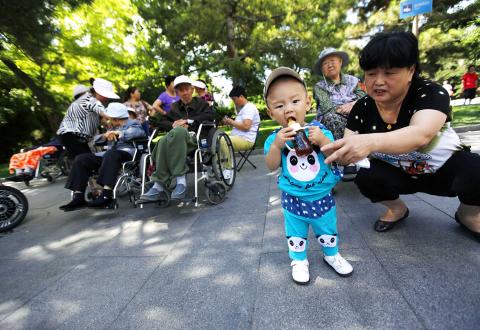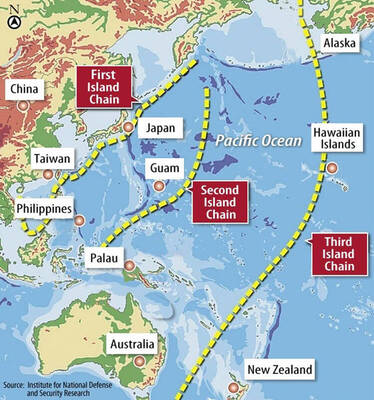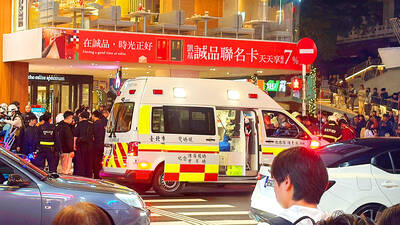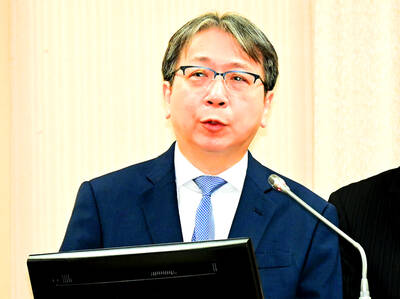China suspended three officials and apologized to a woman who was forced to undergo an abortion seven months into her pregnancy in a case that sparked uproar after graphic photos of the mother and her dead fetus were circulated online.
The moves appeared to be aimed at allaying public anger over a case that has triggered renewed criticism of China’s widely unpopular one-child limit. Designed to control the country’s exploding population, the policy has led to — often violently imposed — forced abortions and sterilizations as local authorities pursue birth quotas set by Beijing.
Feng Jianmei (馮建梅), 23, was beaten by officials and forced to abort her fetus at seven months on June 2 because her family could not afford a 40,000 yuan (US$6,300) fine for having a second child, Chinese media reported this week.

Photo: EPA
Photos of Feng lying on a hospital bed with the blood-covered fetus, reportedly stillborn after a chemical injection killed it, were posted online and went viral, prompting a public outpouring of sympathy and outrage.
The government of Ankang city, where Feng lives in northwest China’s Shaanxi Province, said a deputy mayor visited Feng and her husband in the hospital, apologized to them and said the officials responsible would be suspended amid an investigation.
“Today, I am here on behalf of the municipal government to see you and express our sincere apology to you. I hope to get your understanding,” Ankang Deputy Mayor Du Shouping (杜壽平) said, according to a statement on the city government’s Web site yesterday.
Feng and her husband could not immediately be reached yesterday. A relative who answered Feng’s cellphone said the couple were in talks with city officials.
Xinhua news agency said three officials would be relieved of their duties: two top local family planning officials and the head of the township government.
However, one expert said the officials are unlikely to be seriously punished for a problem that has existed for three decades and that is usually a result of orders carried out to meet the central government’s population quotas.
China legalized abortion in the 1950s, but it did not become common practice until the government began enforcing a one-child limit to stem population growth.
From fewer than 5 million abortions a year before 1979, the number jumped to 8.7 million in 1981, a year after the one-child policy was introduced. It peaked in 1983 at 14.4 million before coming down as China relaxed the policy to allow rural couples a second child if their first was a girl.
Xinhua said Feng was not legally entitled to a second child under China’s one-child limit because she did not have a rural household registration, but added that late-term abortions are prohibited due to the risk of causing physical injury to the mother.
“The correct way to deal with the case would have been for local officials to allow her to deliver the baby first, and then mete out punishment according to regulations,” the agency quoted an anonymous provincial family planning official as saying.
Abuses by family planning officials are often a target for popular frustration, especially amid a growing sense among better-off Chinese that the government has no right to dictate how many children people should have.
One reason that activist Chen Guangcheng (陳光誠) enjoys a wider appeal within China than many other activists is that he and his wife documented complaints about forced abortions and sterilizations in the city that oversees his village.
The couple’s efforts angered local leaders. Chen was jailed and later placed under illegal house arrest, from which he fled six weeks ago in a daring escape. He is now living in New York with his wife and two young children.

The US government has signed defense cooperation agreements with Japan and the Philippines to boost the deterrence capabilities of countries in the first island chain, a report by the National Security Bureau (NSB) showed. The main countries on the first island chain include the two nations and Taiwan. The bureau is to present the report at a meeting of the legislature’s Foreign Affairs and National Defense Committee tomorrow. The US military has deployed Typhon missile systems to Japan’s Yamaguchi Prefecture and Zambales province in the Philippines during their joint military exercises. It has also installed NMESIS anti-ship systems in Japan’s Okinawa

‘WIN-WIN’: The Philippines, and central and eastern European countries are important potential drone cooperation partners, Minister of Foreign Affairs Lin Chia-lung said Minister of Foreign Affairs Lin Chia-lung (林佳龍) in an interview published yesterday confirmed that there are joint ventures between Taiwan and Poland in the drone industry. Lin made the remark in an exclusive interview with the Chinese-language Liberty Times (the Taipei Times’ sister paper). The government-backed Taiwan Excellence Drone International Business Opportunities Alliance and the Polish Chamber of Unmanned Systems on Wednesday last week signed a memorandum of understanding in Poland to develop a “non-China” supply chain for drones and work together on key technologies. Asked if Taiwan prioritized Poland among central and eastern European countries in drone collaboration, Lin

TRAGEDY STRIKES TAIPEI: The suspect died after falling off a building after he threw smoke grenades into Taipei Main Station and went on a killing spree in Zhongshan A 27-year-old suspect allegedly threw smoke grenades in Taipei Main Station and then proceeded to Zhongshan MRT Station in a random killing spree that resulted in the death of the suspect and two other civilians, and seven injured, including one in critical condition, as of press time last night. The suspect, identified as a man surnamed Chang Wen (張文), allegedly began the attack at Taipei Main Station, the Taipei Fire Department said, adding that it received a report at 5:24pm that smoke grenades had been thrown in the station. One man in his 50s was rushed to hospital after a cardiac arrest

ON ALERT: Taiwan’s partners would issue warnings if China attempted to use Interpol to target Taiwanese, and the global body has mechanisms to prevent it, an official said China has stationed two to four people specializing in Taiwan affairs at its embassies in several democratic countries to monitor and harass Taiwanese, actions that the host nations would not tolerate, National Security Bureau (NSB) Director-General Tsai Ming-yen (蔡明彥) said yesterday. Tsai made the comments at a meeting of the legislature’s Foreign Affairs and National Defense Committee, which asked him and Minister of National Defense Wellington Koo (顧立雄) to report on potential conflicts in the Taiwan Strait and military preparedness. Democratic Progressive Party (DPP) Legislator Michelle Lin (林楚茵) expressed concern that Beijing has posted personnel from China’s Taiwan Affairs Office to its